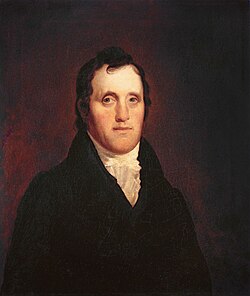Convention
The Old School entertained more serious objections to the national ticket. Duane and Leib were on unfriendly terms with the outgoing administration and were not inclined to accept Madison's anointed successor. The Old School had been steadily marginalized over the preceding decade and saw the caucus system as a mechanism for suppressing democratic dissent. Whereas the New School embraced banking and internal improvements, and many Quids shared the nationalist leanings of the administration, the Old School continued to critique economic and political inequality resulting from unrestrained economic development. After the national caucus nomination of Monroe and Tompkins became known, disaffected Old School Democrats announced plans to hold their own convention at Carlisle on September 19, 1816.
The call for the Carlisle convention went out on August 12, 1816 from a Democratic meeting held at Lancaster, Pennsylvania. Many of the organizers had been prominent in support of DeWitt Clinton during the last election, and some suggested the Old School should adopt Clinton as the Independent candidate for president. Eleven delegates representing the counties of Berks, Cumberland, Dauphin, Lancaster, and Philadelphia ultimately met and nominated a list of 25 electors, including four named on the Caucus ticket, without designating a presidential candidate. Having adopted addresses stating the basis of their opposition to the caucus and the Snyderites, the convention adjourned on September 20.
The address of the convention denounced the caucus system as "dangerous," corrupt, undemocratic, and unconstitutional, "disrespectful" and "contemptuous" of the people, "a practice pregnant with mischief, and which, if continued, must be destructive of Liberty." Considering the tendency of the caucus system to "perpetuate an aristocracy of office in certain Men and States," thus "preventing the free and fair selection by the People themselves," the delegates pledged to "never confide in or vote for any person ... who shall hereafter countenance by his presence or vote any Caucus whatever." [22]
Uncertainty surrounded the presidential vote of the Independent electors, who were formally unpledged. Historian Sanford W. Higginbotham infers that the Independents likely would have voted for Clinton and cites correspondence published in the Aurora, the involvement of prominent Clintonians in planning the Carlisle convention, and Leib's visit to Pittsburgh in December 1815 to drum up support for a Clinton candidacy as evidence of this supposition. Contemporary newspapers gave contradictory reports, variously asserting that the Independent ticket was pledged to Monroe, [24] or a stalking horse for Clinton. [25] The Aurora denied that the Independent electors were committed to any candidate. Phil Lampi assumes the Independents would have voted for Crawford or King, although neither man was a candidate when the Carlisle convention met. In fact, of the 25 electors nominated by the Carlisle convention, Thomas Patterson, Joseph Huston, John Harrison, and James Meloy ran jointly on the Caucus ticket, were elected, and voted for Monroe and Tompkins, while Charles Thomson had announced his intention to vote for Clinton as early as August 1816.














